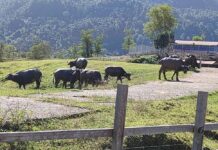FOR the last two years, ISAAA SEAsiaCenter has assisted Myanmar in establishing its National Biosafety Framework, in partnership with the Ministry of Agriculture, Livestock and Irrigation (MOALI), the Plant Biotech Center, and the United States Department of Agriculture’s Foreign Agricultural Service (USDA FAS). After a series of capacity building seminars and workshops for researchers and regulators in 2019, Myanmar is in the last stage of finalizing its Biosafety Framework. The country’s government officials are also setting up its Biotechnology Information Portal to support the Framework by showcasing Myanmar’s acceptance and continuous adoption of biotechnology.
Myanmar’s National Biosafety Framework is composed of biosafety and environmental guidelines that will be used to assess products being developed for food and feed using biotechnology. It is expected to be approved and launched in a few months. To support this milestone, the country is also setting up its Biotechnology Information Portal, which is intended to be a one-stop site where information about Myanmar’s and international biosafety and biotechnology regulations will be easily accessible to the public, and scientists and technical workers are encouraged to contribute news materials for its development. To equip them with proper knowledge on how to create popularized science-based content for the portal, ISAAA alongside MOALI, the Plant Biotech Center, and USDA FAS with the assistance of the Malaysian Biotechnology Information Center (MABIC) organized an online science communication workshop from September 28 to October 1, 2020.
The four-day workshop was attended by around 30 scientists and researchers from MOALI and the Plant Biotech Center. The participants were trained on how to effectively write messages, news, and social media posts that are backed by sound, scientific information. After each session, a discussion tackled the questions raised by the participants during the lectures. Exercises and take-home assignments were also given to the participants at the end of each session and these are evaluated by the resource speakers.
The workshop’s resource speakers included ISAAA Global Coordinator and MABIC Executive Director Dr. Mahaletchumy Arujanan who discussed the principles of science communication and creating effective messages. Joseph Masilamany, co-founder of the Petri Dish, Malaysia’s first science newspaper, discussed writing popular science articles, press releases, and short narratives. Popularizing science news through the social media were discussed by ISAAA social media managers. Kristine Grace N. Tome gave an overview of the importance of social media platforms in reaching out to the public. She also explained how to writing effective science materials for Facebook. Clement Dionglay discussed how to craft messages for Twitter, how to write blog entries, and create attractive infographics. Eric John Azucena, provides tips on how to select the best photographs for science articles and posts. SEAsiaCenter Director Dr. Rhodora Romero-Aldemita and Associate Scientist Panfilo de Guzman were the workshop’s moderators.
The participants are expected to gain understanding about the importance and of science communication. They should be able to to effectively reach out to different audiences not just in Myanmar but also in other countries. They are also expected to be able to conduct communication campaigns to promote science news and facts to promote Myanmar’s biotechnology research and development and other activities. A Biotechnology Information Portal backed by credible scientists with science communication experience will be advantageous to Myanmar as the country gains more ground in establishing its reputation in the scientific and biosafety community.

















